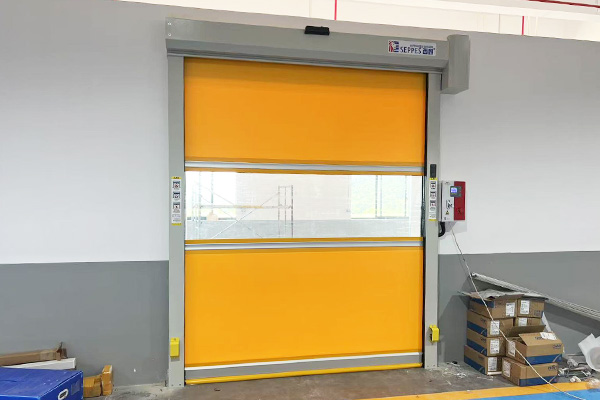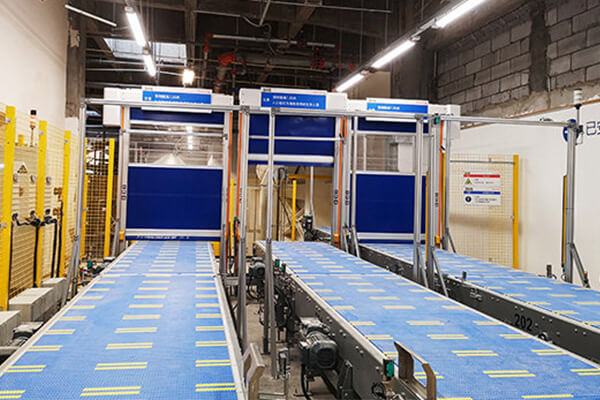Contents
- 1 Introduction: The Implementational Challenge of Battery Production
- 2 Why Conventional Industrial Doors Fall Short in Battery Production
- 3 Advantages and Disadvantages of High-Speed Roll-Up Doors vs Traditional Roller Doors
- 4 Advantages of High-Speed Industrial Doors in German Automotive Battery Manufacturing Plants
- 5 Features of Industrial High-Speed Roll-Up Doors for the Automotive Battery Industry
- 6 SEPPES Rapid Door Powers VW’s Battery Production in Germany
- 7 How to Choose the Right High-Speed Roll-Up Doors for Your Factory
- 7.1 Door Size and Specifications
- 7.2 Energy Efficiency Features
- 7.3 Security Requirements
- 7.4 Cost and ROI Analysis
- 7.5 Conclusion
- 7.6 FAQs
- 7.7 What materials are best for high-speed roll-up doors in battery production?
- 7.8 How long do fast roll-up doors last in high-traffic environments?
- 7.9 Are high-speed roll-up doors energy-efficient for automotive battery factories?
- 7.10 What maintenance is required for high-speed roll-up doors?
Introduction: The Implementational Challenge of Battery Production
Germany remains one of the world’s strongest manufacturers of electrical vehicles (EV), making it a beacon of technological advancement. Particularly important is the production of batteries, where the pursuit of efficiency, safety, and sustainability is unending. Automotive battery production facilities are challenged with precise climate control to keep the area dry, decontamination of clean rooms, automated transport of semi-finished products, and the ever-present danger of fire posed by lithium-ion batteries. A less known device, industrial high speed roll-up doors, is an example of how modern battery manufacturing plants can boost climate control safety integration, while improving industrial throughput and sharpening their competitive edge.
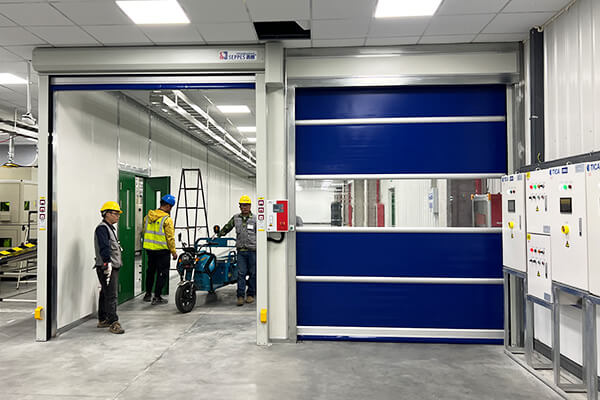
Why Conventional Industrial Doors Fall Short in Battery Production
Slow Speeds
Traditional roller shutters often struggle with slow operational speeds, creating bottlenecks in production workflows. For manufacturing lines relying heavily on automation and automated guided vehicles (AGVs), such delays disrupt the intricate timing necessary for peak efficiency.
Poor Environmental Control
Outdated industrial roller doors often lack effective sealing and exhibit slow closing times, leading to issues such as energy wastage, temperature fluctuation, and humidity intrusion. These factors not only raise operational costs but also jeopardize battery quality, which is highly sensitive to environmental changes.
Limited Safety & Durability
Older door models often fail to meet the high safety standards required for 24/7 battery production plants. From lacking advanced sensors to struggling with continuous high-cycle operations, they fall short of the resilience and technology required in such demanding environments.
Advantages and Disadvantages of High-Speed Roll-Up Doors vs Traditional Roller Doors
Traditional industrial roller doors cost less, have a low cost of maintenance, and are more dependable in low traffic areas. However, they do have slower operation speeds, less energy efficiency, as well as higher wear and tear. Industrial high speed roll up doors, on the other hand, have faster operation speeds, better energy efficiency, and improved security. However, these do come with higher costs, are tnot suitable for all work environments, and require frequent maintenance.
Comparison Table: Traditional Industrial Roller Doors vs. High-Speed Roll-Up Doors
| Aspect | Traditional Industrial Roller Doors | High-Speed Roll-Up Doors |
|---|---|---|
| Speed of Operation | Slower, manual or standard automatic operation | Faster, quick open/close cycle |
| Energy Efficiency | Less energy-efficient due to slower opening/closing and gaps | More energy-efficient, quick closure reduces temperature loss |
| Cost | Generally lower initial cost | Higher upfront cost due to advanced features |
| Durability | Suitable for low-traffic environments, less wear and tear | Higher wear in high-traffic areas, but more durable with regular maintenance |
| Security | Basic security features, often vulnerable to forced entry | Enhanced security features, such as reinforced materials and sensors |
| Maintenance | Lower maintenance costs but may require more frequent repairs over time | Higher maintenance requirements due to motorized systems and advanced technology |
| Space Efficiency | Requires more space for operation due to slower movement and larger footprint | Space-saving design, ideal for tight spaces or high-traffic areas |
| Safety | Basic safety features, like manual locks and minimal sensors | Advanced safety features, such as sensors and emergency stops |
| Customization | Less customizable in terms of speed and features | Highly customizable with automation, sensors, and materials |
| Application Environments | Best suited for warehouses or areas with lower traffic and no strict temperature control | Ideal for high-traffic areas, temperature-sensitive environments (e.g., cold storage, food processing) |
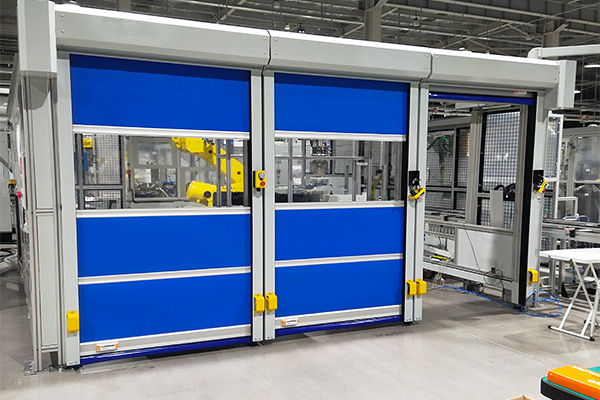
Advantages of High-Speed Industrial Doors in German Automotive Battery Manufacturing Plants
Improved Workflow and Productivity
Vertical opening and closing speed of high speed industrial doors is set at 0.8 to 1.5 m/s, which is significantly faster than the conventional doors. These speed-range high doors greatly reduce the wait time for personnel and vehicles to move in and out of busy areas, making the industrial doors a great addition to high traffic areas.
Enhanced Temperature Control
Heat and energy waste are minimized with rapid roller doors, which are energy-efficient air exchange minimizers. These high speed industrial doors are essential in producing and controlling the environment during the production of automotive batteries to deliver high-quality products by controlling the internal temperature of the workspace and energy in the workspace.
Contamination Control
High speed roller shutter doors are ideal for cleanrooms as they shut quickly and reduce air exchange that restricts the entry of clean air, hence restricting the exposure of the workspace to external contaminants. The reduced shut time of high speed doors insures that the doors are not open for long, which helps restrict the entry of dust, dirt and airborne contaminants. Moreover, high speed doors are equipped with strong cleanable surfaces that can also be washed and sterilized to ensure they meet the high hygiene standards required in sensitive manufacturing processes. They are both efficient and reliable in providing a clean workspace devoid of contaminants.
Safety Features
For the protection of personnel and equipment, the high speed doors are fitted with safety features such as photoelectric sensors and collision avoidance systems. For safety, the photoelectric sensors stop the door from opening and closing. Additionally, collision avoidance systems stop the door from working if there is any possibility of damage or injury. These systems greatly reduce the chance of accidents while speeding up work processes, even in busy areas.
Durability and Longevity
The servo motor of the rapid doors is equipped with a high-precision German motor that is famous for its high standards in reliability and performance. It is built in a way that allows it to withstand tens of thousands of cycles of use to ensure optimum performance in demanding industrial settings.
Features of Industrial High-Speed Roll-Up Doors for the Automotive Battery Industry
Material and Durability
High speed roll-up doors for automobile battery plants are made from tough and heavy-duty materials like PVC and steel to withstand the rigors of the production workplace. These materials are selected specifically due to their wear and high-frequency level of use durability. PVC provides flexibility and durability while painted steel gives strength and structural integrity which offers the doors mechanical and environmental stress resilience. All materials used provide the needed performance for the demanding environment of automobile battery production facilities.
Customized Options
Automobile battery production facilities have these doors tailored to meet their specific needs, improving ease of use and efficiency. See-through windows are an example of enhanced functionality as they provide natural lighting. Other add-ons allow controlling the doors from a distance through wireless technology, remote access, improving efficiency. These unique customized options make the doors to be tailored to specific operational needs.
Automation and Integration
High-speed pvc doors play a crucial role in modern factory settings, seamlessly integrating with automated systems to optimize efficiency and streamline operations. These doors can be connected to advanced industrial control systems, allowing synchronized operation with other machinery and workflows. For example, sensors and programmable logic controllers (PLCs) can automate door movements based on real-time inputs, such as the arrival of forklifts or the movement of goods along conveyor systems. This minimizes downtime and eliminates the need for manual intervention.
SEPPES Rapid Door Powers VW’s Battery Production in Germany
The automotive industry continues to push boundaries in manufacturing efficiency, particularly as electric vehicle production scales globally. A recent installation at Volkswagen’s German manufacturing facility demonstrates how cutting-edge industrial door technology can revolutionize production workflows in car battery manufacturing.
SEPPES, a leading manufacturer of high-speed industrial doors, successfully exported and installed their rapid door system at Volkswagen’s battery production workshop in Germany.
The Challenge: Meeting Automotive Manufacturing Demands
Volkswagen’s battery production workshop operates under strict environmental and safety requirements. The facility must maintain precise temperature control, prevent contamination, and ensure seamless workflow for personnel and equipment. Traditional industrial doors simply couldn’t meet the rapid cycling demands and environmental standards required for modern battery manufacturing.
- The German automotive giant needed a solution that would:
- Support high-frequency operations with minimal downtime
- Maintain sterile production environments
- Comply with European safety standards
- Enhance energy efficiency
- Improve overall production flow
SEPPES Rapid Door: Engineering Excellence
The SEPPES rapid door system installed at the Volkswagen manufacturing plant represents advanced German engineering standards. These high-performance doors operate at speeds reaching up to 2000mm per second, significantly faster than conventional industrial doors.
Key Technical Specifications
| Technical Parameter | Description |
|---|---|
| Door Material | High-quality PVC (Polyvinyl Chloride) fabric |
| Opening Speed | 1.5 – 2.5 meters per second (depending on model) |
| Closing Speed | 0.8 – 1.5 meters per second |
| Max Door Width | 3,000 mm to 6,000 mm (custom sizes available) |
| Max Door Height | 3,500 mm to 5,000 mm (custom sizes available) |
| Door Type | Rolling or vertical lift design |
| Insulation | Options available for insulated PVC (R-value may vary) |
| Power Supply | 380V / 50Hz or 220V / 50Hz (customizable based on requirements) |
| Motor Power | 0.75 kW to 1.5 kW (depending on door size and configuration) |
| Temperature Range | -20°C to +70°C (temperature-resistant variants available) |
| Wind Resistance | Up to 80 km/h (depending on size and model) |
| Safety Features | Photocells, safety edges, and emergency stop systems |
| Control Options | Manual switch, remote control, induction loops, photoelectric sensors |
| Service Life | 500,000 to 1,000,000 opening/closing cycles (depending on usage) |
| Frame Material | Galvanized steel, stainless steel, or aluminum |
| Finish Options | Powder-coated or stainless steel finishes |
| Sealing | Air-tight and weatherproof seals with rubber profiles |
| Applications | Warehouses, cold storage, loading docks, food processing, logistics |
The SEPPES high speed roller door installation at Volkswagen’s car battery production workshop in Germany represents more than just a successful export project. It demonstrates how innovative industrial door technology can enhance manufacturing efficiency while meeting stringent European standards.
As automotive manufacturers worldwide seek to optimize production efficiency and meet environmental standards, the SEPPES rapid door solution at Volkswagen’s German facility serves as a compelling case study for industrial advancement.
The project’s success reinforces SEPPES’ position as a leading provider of high-performance industrial doors, capable of meeting the most demanding manufacturing requirements while delivering measurable operational improvements.
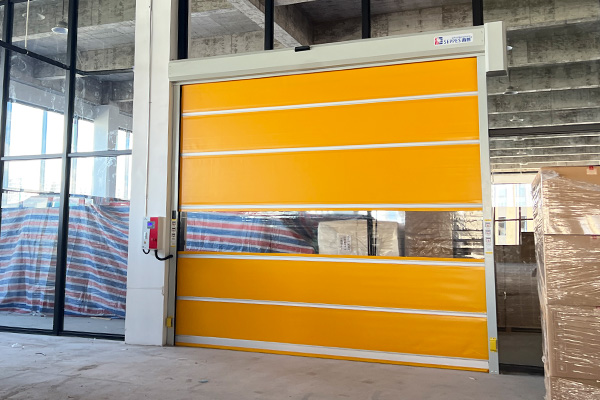
How to Choose the Right High-Speed Roll-Up Doors for Your Factory
Door Size and Specifications
Selecting the appropriate size, speed, and materials is crucial to meet your factory’s operational needs. Consider the dimensions of the door opening, the frequency of use, and the type of traffic (e.g., forklifts, personnel) to determine the required speed and durability. Materials like high-grade aluminum or steel are ideal for high-traffic and heavy-duty environments.
Energy Efficiency Features
Evaluate the door’s insulation and sealing capabilities to ensure optimal energy savings. Look for features like thermal insulation panels, tight seals, and rapid opening/closing speeds to minimize air exchange and maintain stable internal temperatures, especially in temperature-sensitive environments like cold storage or cleanrooms.
Security Requirements
Ensure the door includes advanced safety and security features to protect both personnel and assets. Automatic sensors, such as photoelectric beams and collision detection systems, enhance safety by preventing accidents. Additionally, robust locking mechanisms and reinforced materials provide added security against unauthorized access or external threats.
Cost and ROI Analysis
- Initial Investment: A breakdown of costs for installing high-speed roll-up doors in automotive battery factories.
- Long-Term Savings: How these doors can help reduce energy costs, improve productivity, and lower overall maintenance expenses.
- Return on Investment (ROI): Calculating the ROI for high-speed doors, including factors like energy savings, reduced downtime, and enhanced security.
Conclusion
For automotive battery manufacturing plants, industrial high-speed roll-up doors offer a notable combination of efficiency, security, and cost. These doors lower energy use, reduce safety and contamination risks, boost production and workflow efficiency, and enhance safety. Also, these doors are a practical investment for facilities that prioritize modernization and eco-friendliness, as they offer rapid ROI and long-term savings. For leaders in the sector striving to enhance functionality and stay ahead in a shifting marketplace, adopting this solution is a clear operational upgrade.
Some Tips:
Cost: Like any automation component, high-speed roll-up doors for automotive factories have a price range that falls between $8,000 and $25,000, depending on size, materials, and features.
Materials: In regards to battery production environments, I suggest using anti-static or PVC soft curtains and aluminum frames.
Lifespan: These doors typically have a lifespan of 10 to 15 years under continual use, for high traffic environments, experiencing 500,000 to 1 million cycles.
Energy Efficiency: They have tight seals and rapid operation, which improves energy efficiency by 40% on heating and cooling loss.
Maintenance: Inspections and servicing are critical on a yearly basis which can add up to $500 to $1,500 each year, if done correctly, will save a lot on servicing down the line by maintaining performance and preserving equipment.
FAQs
What materials are best for high-speed roll-up doors in battery production?
Answer: For battery production environments, aluminum frames with specialized curtain materials are optimal. High-grade aluminum provides excellent corrosion resistance against chemical exposure, while maintaining structural integrity. The curtain should be made from reinforced PVC or polyester fabric with anti-static properties to prevent dust accumulation. For clean room applications, smooth, non-porous surfaces that resist chemical cleaning agents work best. Stainless steel components are recommended for hardware exposed to harsh chemicals, ensuring longevity and maintaining hygiene standards required in battery manufacturing.
How long do fast roll-up doors last in high-traffic environments?
Answer: In automobile manufacturing plants, vertical high-speed roll doors have a lifespan of about 10-15 years with good maintenance. Most industrial doors have a lifecycle of about 500,000 to 1 million cycles. In high traffic areas with 100-200 cycles a day, about a decade and a half of dependable performance is achievable. Premium versions with reinforced construction and direct-drive motors may exceed this. The most important determining factors are: number of cycles, the conditions of the environment, maintenance, and the quality of the door at the start. The overall lifespan of a system can be improved with good preventative maintenance.
Are high-speed roll-up doors energy-efficient for automotive battery factories?
Answer: Yes, high-speed roll-up doors are highly energy-efficient for automotive battery factories. Their rapid opening and closing speeds (typically 800-2000mm per second) minimize air exchange, reducing heating and cooling losses by up to 30-40%. The tight sealing systems maintain stable internal temperatures, crucial for battery production environments. Quick operation also minimizes contamination risks and maintains controlled atmospheres, making them ideal for climate-sensitive battery manufacturing processes.
What maintenance is required for high-speed roll-up doors?
Answer: Fast roll-up doors require minimal but consistent maintenance to ensure optimal performance. Monthly inspections should include checking curtain condition, cleaning photo sensors, and lubricating moving parts. Quarterly maintenance involves examining motor operation, testing safety systems, and inspecting seals and guides. Annual professional servicing includes comprehensive system checks, motor calibration, and component replacement as needed.
- Design and development of a roll-to-roll machine for continuous high-speed microcontact printing – Published by MIT, this resource discusses high-speed roll mechanisms and their industrial applications.
- Northwest Energy Efficient Manufactured Housing Program: High Performance Manufactured Home Prototyping and Construction Development – A report from the U.S. Department of Energy’s OSTI, discussing energy-efficient industrial solutions, including high-performance doors.

